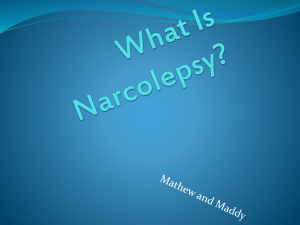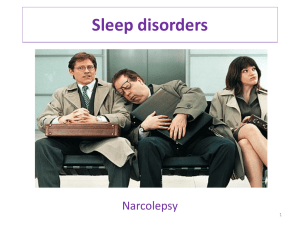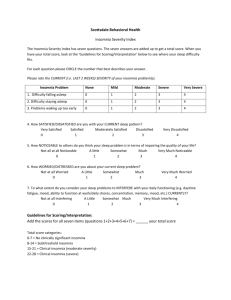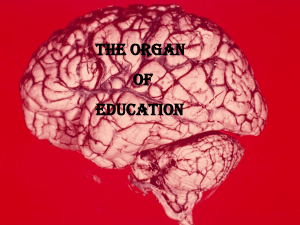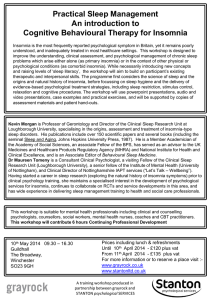Disorders of sleep
advertisement
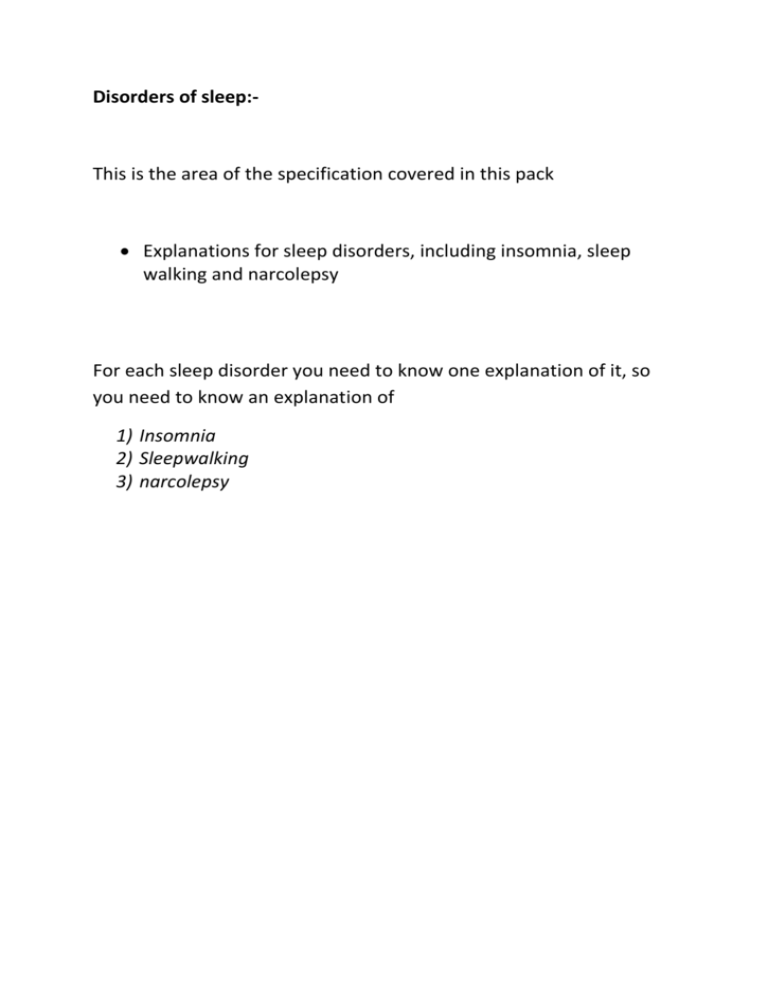
Disorders of sleep:- This is the area of the specification covered in this pack Explanations for sleep disorders, including insomnia, sleep walking and narcolepsy For each sleep disorder you need to know one explanation of it, so you need to know an explanation of 1) Insomnia 2) Sleepwalking 3) narcolepsy Narcolepsy: genes and hypocretin AO1: A fairly new theory links narcolepsy, genes and the neurotransmitter hypocretin. Hypocretin (also called orexin) is a neurotransmitter that regulates arousal, wakefulness, and appetite. The brain contains very few cells that produce orexin: in a human brain, about 10,000 to 20,000 neurons in the hypothalamus. Some genetic variations on chromosome 6 (known as the HLA complex) predispose an individual to narcolepsy. These variations increase the risk of an auto-immune response to neurons in the brain that produce the neurotransmitter hypocretin (also known as orexin). Hence people with narcolepsy often have vastly reduced numbers of neurons in their brain that produce hypocretin, because the cells that produce it have been destroyed by the auto-immune response. It is also possible that for some people the auto-immune response is not caused by genes but by a flu vaccination. Evaluation IDA This explanation of narcolepsy could be deemed reductionist, because it suggests that the disorder is caused solely by biological factors, in this case a genetic variation leading to an auto-immune response to the neurotransmitter, hypocretin. It does not explain the environmental conditions needed for the disorder to develop and is therefore likely to be an oversimplified theory. On the other hand, it provides hope for people suffering from narcolepsy because it may eventually lead to an effective treatment or even a cure. Research evidence Evidence 1 Mignot et al found that out of 16 pairs of mono-zygotic twins, where at least one of the pair has the condition, 5 pairs were concordant for narcolepsy (each twin displayed the condition). This research supports the explanation, as the concordance rate is much higher than the general population (you have a 30% chance of narcolepsy if your identical twin has it). However, the fact it isn’t a 100% concordance rate shows that narcolepsy isn’t entirely genetic. Evidence 2 Broughton (1999) reported that lifestyle adjustments, such as regulated sleep schedules and relaxing before bed, were more successful at treating the symptoms of narcolepsy than drugs. This suggests that lifestyle plays an important role in managing narcolepsy, which means that it may also play a role in development of the condition. The above theory overlooks the importance of lifestyle, which means that it is insufficient to account for these data. Evidence 3 Nishino et al found a link between low levels of hypocretin in the human cerebrospinal fluid and narcoleptic symptoms. This study seems to support the theory because it is the hypocretin which regulates arousal and wakefulness, therefore if there are decreased levels of hypocretin in the cerebrospinal fluid then it is logical to assume an equal decrease in wakefulness. Additional evidence Mignot et al (1999) found that dogs with narcolepsy had a defective hypocretin receptor 2 gene. This supports the theory of a genetic cause of narcolepsy, as dogs with the gene all suffered narcolepsy and sudden fall into REM sleep. The lack of function in hypocretin receptors could have the same effect of destroying the cells in the hypothalamus which produce the neurotransmitterthe overall effect is that hypocretin does not have an effect. Dement (1999) found evidence to support the hypocretin’s role in narcolepsy. They found that mice who could not make the neurotransmitter in their brains developed symptoms of narcolepsy, including sleep attacks and cataplexy. This study supports the biological theory of narcolepsy because it highlights how certain failures in brain producing specific neurotransmitters can result in symptoms similar to that of narcolepsy such as total loss of muscle control (as in cataplexy) and the attacks of sleep synonymous with narcolepsy. Montplaisir (2007) found abnormal numbers of hypocretinergic and dopaminergic neurons in the brainstems of 16 narcoleptic patients. This suggests that an imbalance of neurotransmitters is associated with narcolepsy. Furthermore it confirms that abnormal levels of hypocretin in the brain may be responsible for the condition. However, it also suggests the involvement of dopamine, so hypocretin alone may not be sufficient to account for the development of narcolepsy in all cases AO3: The research consistently shows a link between hypocretin and narcolepsy therefore it can be seen as reliable evidence for the theory. Also, much of the research uses scientific methods therefore they are free from bias from the researcher which could improve the overall validity of the research into hypocretin explanation. The use of animal studies can’t always be generalised to humans, however in relation to Mignot’s study the hypocretin receptor 2 gene is found in both humans and dogs. This means that the same gene may underpin the condition in both species, though further testing would be needed to confirm Although Broughton’s study gives us useful information about how environmental factors may influence narcoleptic episodes, it doesn’t give us any information about the actual cause of the disorder. Overall evaluation This explanation focuses on narcolepsy being down to nature rather than nurture which has led to practical applications in terms of treatments. Most treatments which have been developed are biological in nature such as drug therapy (e.g. Modafinil,) to combat sleep onset during the day. Many studies into narcolepsy are derived from animal studies, the impact of this is that the results cannot be generalised to a human population. This is because of the differences between the neurological makeup of humans and mice for example. A reduction in generalizability reduces the extent to which the theory can be applicable and useful to a human population. However the biological research into narcolepsy is generally correlational. This is an issue because correlational studies cannot show distinctive cause and effect relationships due to the uncontrolled nature of the studies which allows unaccounted for confounding variables to reduce the validity of the results. However when used in accordance with animal studies they can provide a useful insight into seemingly interlinked aspects of the brain. Primary insomnia: predisposing, precipitating and perpetuating factors AO1: Speilman and Glovinsky (1991) said that predisposing, precipitating and perpetuating factors explain primary insomnia. Predisposing factors include a genetic vulnerability to insomnia and the physiological state of hyperarousal. Hyperarousal is high physiological arousal when awake or asleep and it makes it more difficult for the individual to fall asleep. Precipitating factors include stress or environmental change that may temporarily make it difficult to get to sleep. Environmental change includes changing time zones. Females suffer more from primary insomnia, as do older people so both of these factors count as precipitating factors. Perpetuating factors maintain insomnia when the precipitating factors have gone. They include being tense when going to sleep or the expectation of poor sleep. These perpetuating factors are key to chronic primary insomnia. Evaluation IDA The theory follows the nature nurture debate on insomnia, as the predisposing part of the theory emphasises the nature argument towards a genetic predisposition to having insomnia, while the precipitating part focuses on environmental factors such as stress which lead to insomnia. An advantage of the nature side to the theory is it can easily be tested in an experimental and scientific manner. If insomnia is due to genetic and physiological factors it is likely treatments can be produced to prevent insomnia or reduce its symptoms. However the nurture side means we can inform people of environments that lead to stress thus increasing likelihood of insomnia. Research evidence Evidence 1 Nofzinger et al (2004) found that the transition from being awake to being asleep is usually associated with a decrease in activity in the brain stem, thalamus and prefrontal cortex. Using PET scans, Nolfzinger et al showed that insomniacs experienced a smaller decline in such activity when going to sleep. In fact, they found elevated level of activity in the brains of insomniacs. This suggests that people who suffer from insomnia do so due to high physiological arousal which supports the biological element of the explanation for insomnia. Evidence 2 Bastien et al. (2004) found that 60% of patients with insomnia could identify a trigger for their sleep disturbance, and these tended to be around family, work/school and health. This study supports the idea that precipitating factors have an effect on insomnia because the stress of external factors such family problems (divorce) may have an effect on their health resulting in them not being able to sleep. Evidence 3 Ohayon & Roth (2003) interviewed 14,195 participants representative of the general populations of the UK, Italy, Portugal and Germany over the telephone about their psychiatric history and their sleep patterns. They found that people with insomnia were six times more likely to report a mental health problem, such as depression or anxiety, than people without insomnia. This suggests that there are also psychological factors that can be linked to suffering from insomnia. AO3: The use of experimental research allows for more objective results to be gathered. Specifically, Nofzinger used scientific equipment (PET scans) to make comparisons between people with insomnia and people who do not have insomnia. This increases the validity of the research and provides the explanation with strong scientific support. However, the research into precipitating and perpetuating factors often use non-experimental, selfreport techniques to gather data which means the validity of this research can be questioned due to issues such as social desirability bias. This means that the environmental aspects of the explanation can be criticised as firm conclusions about how these are linked to insomnia are difficult to confirm. Overall evaluation As the theory has focussed on both biological and environmental factors, treatments have included drug treatment, usually only prescribed for a short term, and cognitive behavioural therapy which targets the mental and stress factors which contribute to insomnia. The explanation for insomnia states there can be multiple factors which lead to insomnia; this is useful as it takes into account many factors (holistic explanation rather than reductionist). However it could be argued that due to this, it is very difficult to study these factors separately and to determine which factors are the most prevalent in causing insomnia thus making it more problematic to know what precise treatment to offer. Sleep walking: a diathesis-stress model AO1: A diathesis-stress model recognises that there are predisposing factors (the diathesis) and environmental causes to a disorder (the stress). It is important to realise that sleepwalking occurs in SWS. This model of sleepwalking says that there is a genetic predisposition to sleep walking, which is the diathesis; this genetic predisposition is likely to be incomplete arousal – so people’s genes predispose them to be in this state, which is a state between sleep and wakefulness. Sleepwalking occurs in SWS and typical EEG recordings taken during sleepwalking show delta waves typical of SWS plus higher frequency beta waves which are characteristic of an awake state. Hence it appears that sleepwalking occurs when the person in SWS is awakened but the arousal of the brain is incomplete so they still appear asleep. The stress (environmental) factors that make sleepwalking more likely to occur in those with a predisposition include sleep deprivation, drinking alcohol, fever and being a child. Children are thought to be more vulnerable because they have more SWS than adults and it’s thought that the mechanism that inhibits motor activity during SWS is not properly matured. Hormonal changes during puberty and menstruation may also be triggers for sleepwalking. Evaluation IDA The diathesis-stress model suggests sleepwalking has a biological basis whilst still taking into account environmental factors that may influence this behaviour. This can be considered useful as it leads to a less reductionist explanation of sleepwalking which could have important implications for the way we treat people who have the disorder. It suggests that although there may be a genetic predisposition, there may be ways in which we can help those affected manage the impact of their biology. Therefore it is a more positive outlook for the individual than if we concentrated on the impact of biology alone Research evidence Evidence 1 Ohayon researched a sample of 19,136 individuals from 15 states of the U.S. The study showed that people with depression were 3.5 times more likely to sleepwalk than those without, and people with alcohol abuse/dependence or obsessive-compulsive disorder were also significantly more likely to have sleepwalking episodes. This evidence supports the stress part of the explanation as it shows that environmental factors increase the amount of sleepwalking that occurs in individuals for example those who drink a lot of alcohol increased their time spent in SWS sleep which therefore could increase their chances of sleep walking. Evidence 2 Hublin et al (1997) Monozygotic (1045) and dizygotic (1899) twins were interviewed about their sleepwalking habits in childhood and adulthood. The study found that there was a link between genetics and sleepwalking. which suggests that one can be predisposed to sleepwalking, supporting the diathesis idea. Evidence 3 Oliviero (2008) examined the motor excitability of adult sleepwalkers during wakefulness. Compared to normal controls, the sleepwalkers had signs of immaturity in the relevant neural circuits. This evidence supports the diathesis-stress model, since the participants’ neural circuits were not fully developed, therefore could not reduce motor activity. This led to a state of semi-wakefulness, causing sleep-walking. The study also supports the finding that children sleepwalk more than adults as their brains are still developing. Additional evidence Zadra et al (2008) investigated 40 patients and recorded sleepwalking for one baseline night and during recovery sleep after 25 hours of sleep deprivation. The results show that 32 episodes were recorded from 20 sleepwalkers (50%) at baseline whereas recovery sleep resulted in 92 episodes being recorded from 36 patients (90%). This study also supports the model because the participants were subject to stress caused by sleep deprivation. Most patients who were deprived of sleep showed sleepwalking. AO3: Ohayon and Hublin both used a large sample which increases the population validity enabling the results on the sleepwalking to be generalised to the wider population. increasing the extent to which we can use the diathesis-stress model to explain why people within the wider population sleep walk. Research conducted in sleep labs are low in ecological validity as the environment is atypical to the one in which the participant would normally sleep. This means the findings may be difficult to generalise to real life situations of sleep walking. This could potentially lower the extent to which we can explain sleepwalking using the diathesis-stress model. Overall evaluation This explanation doesn’t tell us why incomplete arousal occurs, and why it only occurs in some people but not others, therefore it is more of a description of what happens during sleepwalking, rather than an explanation of why it occurs. This could be the reason as to why no specific treatment (at the time) is given for sleepwalking, it is mainly recommended that sufferers try to establish a regular bed time routine in order for them to relax and get enough sleep. People who suffer from sleepwalking could also be advised to reduce their alcohol consumption, and go to bed earlier, since alcohol digestion and sleep deprivation have been shown to contribute to sleepwalking.
